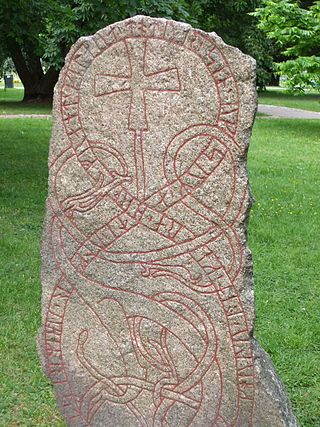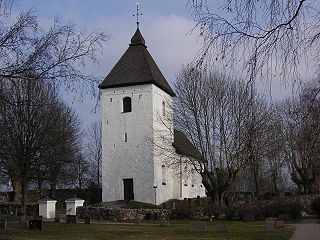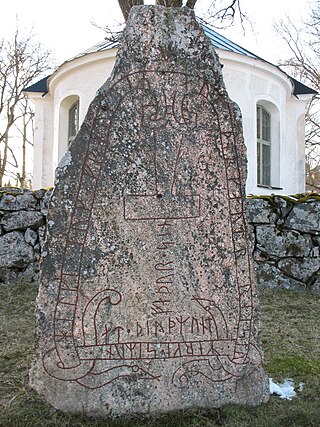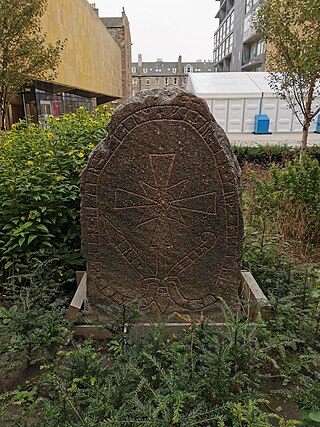Younger Futhark runestones
The England runestones
The England runestones are a group of about 30 runestones located mostly in Sweden, with some in Norway, Denmark and northern Germany, which refer to Viking Age voyages to England. [9]
Scandinavia proper
Sweden

The number of runestones in Sweden is estimated at between 1,700 [2] and 2,500 (depending on definition). [2]
The Swedish district of Uppland has the highest concentration with as many as 1,196 inscriptions in stone, whereas Södermanland is second with 391). [10]
- Varangian Runestones – inscriptions that mention voyages to the East (Austr) or the Eastern route (Austrvegr).
- Ingvar Runestones – 26 Varangian runestones that were raised in commemoration of those who died in the Swedish Viking expedition to the Caspian Sea of Ingvar the Far-Travelled.
- Serkland Runestones – six or seven runestones which are Varangian Runestones that mention voyages to Serkland, the Old Norse name for the Muslim world in the south.
- Greece Runestones – 29 Varangian runestones that talk of voyages to Greece, i.e. the Byzantine Empire.
- Viking Runestones – Stones that mention Scandinavians who participated in Viking expeditions in western Europe, and stones that mention men who were Viking warriors and/or died while travelling in the West.
- Jarlabanke Runestones – a collection of 20 runestones written in Old Norse related to Jarlabanke Ingefastsson and his clan.
- Frösöstenen
- The Ramsund carving
- Sparlösa Runestone
- Rökstenen – the longest runic inscription in the world, located in the province of Östergötland in Sweden
District of Hälsingland
District of Medelpad
District of Småland
District of Skåne
- Sjörup Runestone
- Hyby Runestones (DR 264 and DR 265)
District of Uppland
- Färentuna Runestones (U 20, U 21 and U 22)
- Broby bro Runestones (U 135, U 136 and U 137)
- Hagby Runestones (U 152, U 153, U 154 and U 155)
- Lingsberg Runestones (U 240, U 241 and U 242)
- Hargs bro runic inscriptions (U 309, U 310 and U 311)
- Snottsta and Vreta stones (U 329, U 330, U 331 and U 332)
- Granby Runestone (U 337)
- Näsby Runestone (U 455)
- Vaksala Runestone (U 961)
- Krogsta Runestone (U 1125)
District Östergötland
District Gästrikland
Denmark
Denmark has a total of 250 known runestones. [2]
Norway
Norway has a total of 50 known runestones. [2]
- Dynna stone (11th century AD)
- Fåberg stone
- Granavollen Runestone (11th century AD)
- Grindheim stone (11th century AD)
- Hønen Runestone (11th century AD)
- Klepp I Runestone
- Kulisteinen (11th century AD)
- Norwegian Runic Inscription 239
- Oddernes stone (11th century AD)
- Svingerud Runestone (between 1st and 3rd centuries AD)
- Vang stone (11th century AD)
North Atlantic
British Isles
- Manx runestones: 31 surviving stones. [4]
- Princes Street Gardens Runestone, Edinburgh, Scotland
Faroe Islands
- Sandavágur stone (13th century)
- Kirkjubøur stone (11th century)
- Fámjin stone (16th century)
Greenland
Other
Germany
- Hedeby stones, Hedeby (10th century AD)
- Sigtrygg Runestones (934 AD)
- Stone of Eric (10th century AD)
Italy
- Piraeus Lion, coming from Greece and today in Venice
- Sanctuary of Monte Sant'Angelo, Apulia (South Italy)
Ukraine
- Berezan' Runestone, Berezan' Island
















